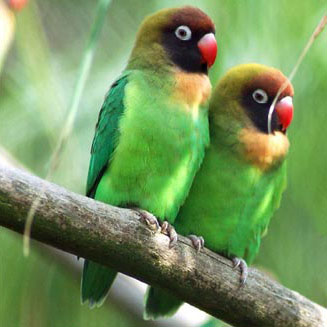|
Agapornis nigrigenis
(Black-cheeked lovebird)
Swartwangparkiet [Afrikaans]; Poro (generic term for
lovebirds) [Kwangali]; Zwartwangagapornis [Dutch]; Inséparable ŕ joues noires
[French]; Rußköpfchen [German]; Inseparável-de-faces-pretas [Portuguese]
Life
> Eukaryotes >
Opisthokonta
> Metazoa (animals) >
Bilateria >
Deuterostomia > Chordata >
Craniata > Vertebrata (vertebrates) > Gnathostomata (jawed
vertebrates) > Teleostomi (teleost fish) > Osteichthyes (bony fish) > Class:
Sarcopterygii (lobe-finned
fish) > Stegocephalia (terrestrial
vertebrates) > Tetrapoda
(four-legged vertebrates) > Reptiliomorpha > Amniota >
Reptilia (reptiles) >
Romeriida > Diapsida > Archosauromorpha > Archosauria >
Dinosauria
(dinosaurs) > Saurischia > Theropoda (bipedal predatory dinosaurs) >
Coelurosauria > Maniraptora > Aves
(birds) > Order: Psittaciformes > Family: Psittacidae
 |
|
|
Black-cheeked lovebirds, London Zoo. [photo wolfieman ©] |
|
The Black-cheeked lovebird is a rare vagrant in southern
Africa, as it has only been reliably recorded once, at Victoria Falls, Zimbabwe.
Its distribution is highly localised, with its population restricted to
south-western Zambia (because of its small, localized population, it is now
considered Vulnerable). It mainly occupies Mopane woodland, but also
Acacia woodland and agricultural areas - it is never far from water. It mainly
eats grass seeds, especially Echinochloa colona (Jungle rice), with the
rest of its diet largely made up of leaves and flowers.
Distribution and habitat
Rare vagrant to southern
Africa, as it has only been reliably recorded once, at Victoria Falls, Zimbabwe
on the 9th of January 1997.
Its distribution is highly localised, with its population restricted to
south-western Zambia, mainly in Mopane woodland, but also Acacia woodland
and agricultural areas - it is never far from water.
Food
It mainly eats grass seeds,
especially Echinochloa colona (Jungle rice), with the
rest of its diet largely made up of leaves and flowers. The following food items have been recorded in its diet:
- Plants
- seeds
- Echinochloa colona (Jungle rice)
- other grass species found in Mopane woodland
- leaves and flowers
- Acacia
- Albizia
- Combretum (bushwillow)
- Capparis tomentosa (Woolly caper-bush)
- Boscia albitrunca (Rough-leaved shepherds-tree)
- Syzygium cordatum (Waterberry)
- Balanites aegyptiaca (Single green-thorn)
- Colosphermum mopane (Mopane)
- Kigelia africana (Sausage-tree)
- Faidherbia albida (Ana-tree)
- Erythrophleum africanum (Ordeal-tree)
- leaf stems
- Acacia nigrescens (Knob-thorn)
- Sclerocarya birrea (Marula)
- fruit
- Ficus sycomorus (Sycomore fig)
- Diospyros mespiliformis (Jackal-berry)
- Phyllanthus reticulatus (Potato-bush)
- bark
- Combretum imberbe (Leadwood)
- Albizia versicolor (Large-leaved albizia)
- resin
- Acacia arenaria (Sand thorn)
- Invertebrate larvae
- Lichen
Threats
Vulnerable, partly due to the cage-bird trade in the
1920s, although it is now under threat by human disturbance in its habitat.
References
-
Hockey PAR, Dean WRJ and Ryan PG (eds) 2005. Roberts
- Birds of southern Africa, VIIth ed. The Trustees of the John Voelcker
Bird Book Fund, Cape Town.
|
